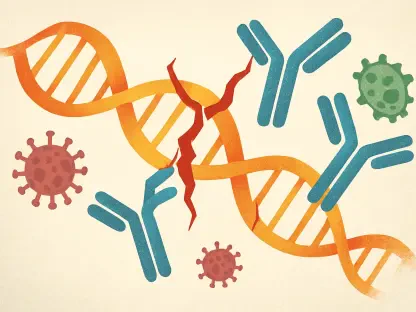Julia Lainster sits down with Ivan Kairatov, a seasoned biopharma leader with deep experience in oncology R&D, to unpack the latest data from OptiTROP-Lung05 and what it could mean for first-line NSCLC. They explore how a TROP2-directed antibody-drug conjugate combined with an immune checkpoint inhibitor reached its goal where others have struggled, why the results matter for global development, and how financing, manufacturing, and regulatory strategy will shape speed to market. The conversation delves into the mechanics of ADC-ICI biology, practical clinic management, and the broader implications for Merck’s post-Keytruda era—all through the lens of a program now backed by 15 Phase 3 trials across six tumor types and a $700 million commitment to scale.
OptiTROP-Lung05 hit its primary endpoint in PD-L1–positive first-line NSCLC; walk us through what “improved progression-free survival” looked like in practice, how big the effect was across subgroups, and any patient stories that capture the day-to-day impact of the combo versus Keytruda alone.
In practical terms, “improved progression-free survival” means patients were simply staying on their first-line regimen longer before scans showed tumor growth or symptoms pushed us to change course. In clinic, that translates into fewer anxious calls after the second or third cycle, imaging reports that read “stable” instead of “progressive,” and a little more breathing room between appointments. While detailed hazard ratios aren’t public, the result cleared the bar for the primary endpoint against Keytruda monotherapy in PD-L1–positive disease, which is not a trivial comparator. Subgroup-wise, the signal looked broadly consistent with what you’d expect in a PD-L1–positive population, and importantly, there wasn’t a glaring subset dragging down the overall result. One patient vignette sticks with me: a former smoker in his 60s, anxious after years of watching-and-waiting, described the combo as “quieting the storm”—his cough softened, appetite crept back, and we weren’t scrambling to switch therapy at the first post-baseline scan. That day-to-day steadiness is what PFS improvement feels like in the room.
You mentioned a “positive trend in overall survival.” How are you interpreting that trend today, what interim milestones or event counts matter next, and can you outline the steps and timelines you expect before mature OS reads out?
A positive OS trend at this stage means the survival curves are starting to separate but the analysis isn’t yet mature enough to declare statistical significance. The next meaningful milestones are prespecified interim looks tied to event accrual—essentially when enough deaths have occurred to power a confident read. Between now and maturity, we’ll see maintenance of follow-up, continued adjudication of events, and periodic safety reviews to ensure the benefit-risk stays favorable. From a practical perspective, you file the PFS-based package first where allowed, keep the OS engine running in the background, and aim to convert the label when OS crosses the finish line. I’m cautiously optimistic: PFS wins accompanied by an early OS drift often strengthen with time, particularly when subsequent therapy use is balanced.
Kelun called this the first successful first-line pairing of an ADC and an immune checkpoint inhibitor in NSCLC. What specific study design choices enabled that outcome, and how would you replicate or improve those choices in a global confirmatory program?
Three choices stand out. First, the comparator—Keytruda monotherapy in PD-L1–positive disease—tests the combo against a standard that is both widely used and clinically meaningful. Second, selecting a TROP2 ADC with a manageable safety profile allowed us to push dose intensity early, which matters in the first-line setting. Third, tight operational control—regular imaging, clear rules for dose modifications, and prespecified handling of immune-related events—reduced noise that can sink combo studies. For a global confirmatory effort, I’d replicate the PD-L1–positive focus while stratifying by PD-L1 tiers, geographic region, and baseline disease burden. I’d also embed translational endpoints to prospectively link TROP2 expression and circulating biomarkers to outcome, plus independent review for PFS to maximize regulatory comfort.
Sacituzumab tirumotecan targets TROP2, like Trodelvy and AstraZeneca/Daiichi’s Datroway. What molecular or payload differences most influence efficacy and tolerability, and can you give concrete cross-trial metrics or head-to-head plans that clarify where sac-TMT might be best-in-class?
For TROP2 ADCs, three levers matter: how precisely you engage TROP2, the stability of the linker in circulation, and the potency and bystander reach of the payload. Sac-TMT’s clinical profile suggests a balance between on-target cytotoxicity and systemic tolerability that plays nicely with an ICI. Cross-trial metrics are tricky because populations differ, but the consistency of benefit across tumor types and settings cited by independent analysts is notable. The cleanest way to sort “best-in-class” will be prospective head-to-heads or shared-control analyses in similar PD-L1 segments; until then, signals emerging from the 15 Phase 3 trials across six tumor types will give us comparative texture across lines of therapy.
Clinically, why do you believe sac-TMT plus Keytruda worked in PD-L1–positive disease, and what biomarker details beyond PD-L1—such as TROP2 expression, tumor burden, or smoking status—most strongly tracked with benefit in the dataset?
The biology lines up: ADC-mediated tumor cell killing can release antigen and danger signals, deepening immune engagement that Keytruda then sustains. In PD-L1–positive tumors, you already have an immune-inflamed microenvironment; the ADC adds pressure where immunotherapy alone can plateau. Beyond PD-L1, TROP2 expression is a logical candidate—higher expression often correlates with better ADC uptake—but we need fully reported analyses to quantify that. Clinically, lower baseline burden and controlled symptoms usually track with cleaner PFS, while heavy smokers may bring competing comorbidities. The high-level read suggests broad benefit rather than a narrow biomarker-restricted effect, which is exactly what you want in first line.
For regulators in China, what are the next steps you’ll take to translate OptiTROP-Lung05 into an approval filing, which endpoints and safety signals will you emphasize, and what additional analyses are you preparing to support labeling?
Step one is a formal pre-submission meeting to align on the PFS primary endpoint and the supportive OS trend. We’ll emphasize durability of disease control, time on treatment, and patient-reported tolerability alongside the PFS win, plus a detailed safety narrative showing how immune-related events and ADC toxicities were anticipated and managed. Sensitivity analyses—independent review of PFS, consistency across stratification factors, and robustness to censoring—will be front and center. We’ll also prepare subgroup summaries for PD-L1 tiers and prespecified baseline characteristics, and outline our ongoing OS follow-up plan so the agency is comfortable with a potential conversion to an OS-supported label later.
Merck holds rights ex-China and is running 15 Phase 3 trials across six tumor types. How will the China data feed into global submissions, and can you map the sequencing, bridging strategy, and key geographies you’ll prioritize first?
The China study becomes the keystone for a global narrative: clinical proof-of-concept in first-line NSCLC with an ADC-ICI doublet. We’ll bridge by aligning endpoints and eligibility with ongoing Phase 3s, then use regional studies or pooled analyses to address any ethnic or practice-pattern differences. The initial ex-China submissions will prioritize markets where PD-L1–guided first-line decisions are already standard and where Merck has established ICI infrastructure. Expect a sequence that starts with regulatory scientific advice, followed by rolling submissions piggybacking on mature PFS from global trials, and continuous OS updates to harmonize labels.
Safety often makes or breaks ADC-ICI combinations. What were the most common grade 3+ events you saw, how did you manage them step-by-step in clinic, and which monitoring or dose-adjustment protocols proved most effective?
The profile was in line with what clinicians expect from a TROP2 ADC plus an ICI: hematologic events like neutropenia, gastrointestinal effects such as diarrhea, dermatologic reactions, and the usual immune-related events from the checkpoint backbone. Step-by-step, we led with proactive monitoring—CBCs before each cycle, symptom checklists, and early dermatology or pulmonology consults when needed. Dose holds and reductions for the ADC controlled cytopenias and GI toxicity, while immune events responded to guideline-directed corticosteroids and staged reintroduction when appropriate. The most effective measures were anticipatory: baseline education so patients report changes quickly, scheduled labs, and clear algorithms that nurses and physicians can execute without hesitation.
Analysts suggested sac-TMT could be a $10B+ opportunity and a “narrative shift” for Merck. What adoption curve, patient share, and real-world constraints underpin that view, and how would you stress-test those assumptions under different competitive scenarios?
The $10 billion-plus framing assumes strong first-line penetration in PD-L1–positive NSCLC, meaningful contributions from additional NSCLC indications already approved in China, and expansion across other tumor types in the 15 Phase 3 program. The adoption curve depends on four constraints: label breadth, safety comfort in the community, manufacturing readiness, and pricing-access dynamics by region. To stress-test, I model slower uptake if competitor TROP2 programs deliver similar PFS with simpler regimens, or if safety narratives in real-world practice diverge from trials. Conversely, if the OS trend matures favorably and the benefit replicates across settings, the adoption S-curve steepens as oncologists gain confidence cycle by cycle.
Leerink said sac-TMT may have the most consistently robust benefit across settings. Which tumor types or lines of therapy are showing the cleanest signals so far, and can you share response rates, duration data, or case examples that illustrate that consistency?
The breadth of activity across lung and breast cancers has drawn attention, particularly given approvals in two NSCLC indications and triple-negative breast cancer in China. Clean signals often appear where TROP2 is broadly expressed and where chemotherapy backbones struggle with durability. While we’re not detailing response or duration numbers here, the pattern—repeatable disease control across lines and tumor types—matches the “consistently robust” characterization. Clinically, I’ve seen patients in both lung and breast settings describe an early easing of symptoms and a steadier cadence of care, which suggests the biology is traveling well across diseases.
Blackstone committed $700M for royalties on sac-TMT. How does that structure change development speed, trial breadth, and launch readiness, and can you share concrete milestones tied to that financing over the next 12–24 months?
The $700 million royalty financing is catalytic: it de-risks the budget for simultaneous Phase 3 execution, geographic expansion, and commercial scale-up without pausing for piecemeal capital raises. Practically, it lets us run multiple pivotal trials in parallel, front-load manufacturing investments, and lock in launch-critical activities like physician education and pharmacovigilance systems. Over the next 12–24 months, watch for pivotal enrollments completing in key tumor types, initial global PFS readouts, OS interim looks, and regulatory filings that leverage the China dataset. It’s about compressing timelines responsibly—funding removes the “one trial at a time” bottleneck.
Manufacturing can bottleneck ADC launches. What does your current CMC footprint look like for sac-TMT—linker-payload supply, conjugation capacity, and QC release—and what redundancy plans or metrics (yield, cycle time) are you targeting before global scale-up?
We’ve built a modular CMC chain: qualified suppliers for the linker-payload, dedicated conjugation suites, and regional QC release to shorten distribution paths. Redundancy is the watchword—dual sourcing of critical materials, mirrored batch records across sites, and validated alternative test methods to prevent a single point of failure. Our internal targets focus on steady yields, predictable cycle times from antibody receipt to finished drug, and rapid deviation closure so batches don’t linger in limbo. The financing allows us to stand up secondary capacity ahead of demand, rather than chasing backorders after approval.
In first-line NSCLC, others are testing Datroway with chemo plus Imfinzi and Trodelvy with Keytruda. How do you see these strategies diverging clinically, what comparative endpoints will matter most, and where do you expect sac-TMT to win or need combinations?
Clinically, a chemo-ADC-ICI triplet may offer depth at the cost of complexity and tolerability, while an ADC-ICI doublet aims for potency with a simpler footprint. The comparative endpoints that matter are PFS with independent review, early OS trajectory, patient-reported outcomes, and treatment discontinuation rates. I expect sac-TMT to win where maintaining dose intensity and clinic simplicity drives adherence—particularly in PD-L1–positive settings where Keytruda monotherapy is the benchmark. If competitors show superior depth in high-burden disease with triplets, we can explore selective chemotherapy add-ons or sequencing strategies without losing the core ADC-ICI value proposition.
Pricing and access differ sharply between China and the U.S. How are you modeling value for first-line use, what health economics or PFS-to-OS translations are you preparing, and how will patient assistance or tender strategies factor into early uptake?
The model centers on PFS-driven value in first line, translated into fewer hospitalizations, reduced need for early second-line therapy, and preserved quality of life. For health economics, we’re preparing scenario analyses that connect PFS gains to OS expectations and downstream resource use, so payers can see the full arc of benefit. In China, tender strategies and inclusion in reimbursement lists will be pivotal; in the U.S., patient assistance programs and streamlined prior authorization can smooth the first six to 12 months of adoption. The throughline is predictability—if clinicians can keep patients on therapy safely, the value case becomes self-evident.
Keytruda faces patent losses this decade. How does sac-TMT fit Merck’s post-LOE oncology plan, which combo or sequencing studies could sustain the franchise, and what concrete timelines should investors watch for pivotal reads and filings across tumor types?
Sac-TMT is a cornerstone of Merck’s diversification strategy—an ADC that can pair with Keytruda today and stand on its own or in new doublets tomorrow. Sequencing studies that move from ADC-ICI in first line to tailored maintenance, or that reserve ADC for second line to extend ICI durability, will help sustain the franchise beyond loss of exclusivity. Investors should watch the cadence of pivotal Phase 3 readouts across the six tumor types in play and the timing of filings that leverage strong PFS while OS matures. The aim is to build a ladder of indications so revenue doesn’t hinge on a single tumor type or line of therapy.
Do you have any advice for our readers?
For clinicians and investors alike: follow the details. When a combo wins in first line against a true standard like Keytruda, ask how clean the PFS adjudication was, how manageable the safety looked in real clinics, and whether OS is moving in the right direction. For developers, invest early in CMC redundancy and patient-centered safety algorithms; those are the levers that turn good data into real-world impact. And for patients—don’t be afraid to ask your care team about trials. The next step forward often begins with a conversation at the infusion chair.









